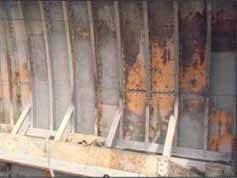PRAIRIE DU SAC – A facility used to thermally treat salvaged metal objects at Badger Army Ammunition Plant is a source of toxic emissions that could be easily eliminated. According to Citizens for Safe Water Around Badger, paint on some of these items is contaminated with high levels of lead, PCBs and other toxins that become volatized and released to the air when heated.
“As open burning/thermal treatment of painted objects at Badger’s decontamination oven may result in the uncontrolled release of dioxins, lead, PCBs, and other bioaccumulative toxins to the environment, we are writing to urge the Army to voluntarily prohibit thermal treatment of paint that exceeds applicable standards,” CSWAB’s September 24 letter said.
The decontamination oven at Badger is an open air thermal treatment unit used to assure that no explosive material is on or in metal objects that will be released to salvage operators. Some of these objects, including flanges, pipes, and other metal objects, are painted.
The high contaminant levels in certain paints were first reported by Plexus Scientific as part of the documentation provided to the WDNR for the proposed open burning of buildings and equipment at Badger. Plexus, a consultant working for the Army, took representative paint samples from various surfaces in buildings at Badger.
PCBs in paint were detected at concentrations as high as 22,000 ppm – levels far above the regulatory limit of 50 ppm. Burning PCBs may, in turn, produce dioxins – persistent bioaccumulative toxins that can move through the environment by many processes including volatilization and long-range transport, CSWAB cautions. Lead was also detected in various paint samples at concentrations as high as 170,000 ppm – again, far above the federal standard of 5,000 ppm.
“In addition to demonstrating the Army’s interest in optimal protection of the environment and acting as a good neighbor, we believe this request will cause the Army no undo hardship as it already routinely handles, stores, and disposes of hazardous wastes and the amount of material involved is, by comparison, exceptionally small,” CSWAB’s letter concluded.

